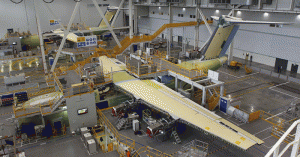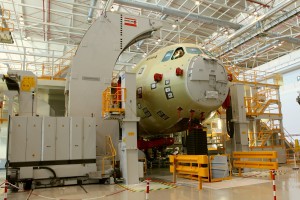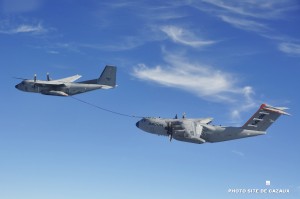2012-10-22 Second Line of Defense visited the Seville final assembly line (FAL) in late September for an update on the delivery schedule and process.
And our guide to the effort was the senior Airbus Military engineer Jesús Portillo, in charge of the A400M Program Management Office.
As with engineers, the approach taken is that there are always problems, and there are always solutions. The task is always resolution.
For a program, which will have at least a 50-year service life, the first planes will be down payments on the future for the countries, which buy them.
The A400M is a new product built in a 21st century way; it is a complex program with many efficiencies and sustainable improvements built in, along with new capabilities for a tanker/lifter aircraft.
The program has been slowed by a well-documented gear box issue evident in the return of the aircraft from its Asian tour and test runs. We got an update on the engines and the progress moving forward as well.
We focused as well on the nature of manufacturing for 21st century aircraft, the machines and the engineering-labor team necessary to manufacture modern aircraft.
The investment in an advanced production base is impressive and one hopes that the ramp up of production, which the base will allow, will come earlier rather than later.
Like the F-35, many analysts and politicians, do not focus on the ramp up possibilities of highly automated assembly lines of the sort represented by the A400M.
And a basic rule of 21st century life, the building of new programs like the F-35 and the A400M, requires massive investments in the production and manufacturing process and as such, the core platforms for the 21st century will be workhorses for a long time to come.
Current Status of the Production Line
SLD: What is the current status on final production and delivery of the first aircraft, in this case to France?

Portillo: The original plan was to fly the initial aircraft for delivery at the end of August and prepare for transfer to the customer. Because of the gear box issue, this has been delayed.
The engine manufacturer has solved the problem, but preferred to have the engines returned to him for modifications involving the gearbox and associated materials. They will soon deliver the modified engine back to us and we will then mate the engines with the aircraft.
In this interim period, we have used the time to do some additional modifications, which we were intending to do at the end of the process now, to ensure that there is not any further delay.
The engine manufacturer took a whole engine approach, not simply plugging in a modified gearbox, and we anticipate getting an operational ready engine back soon.
SLD: So that explains why the 3 aircraft in the test area do not have engines. The three aircraft are 2 for France and 1 for Turkey is that correct?
Portillo: That is correct and we anticipate the 4th aircraft shortly after that which will go to France as well. The delivery schedule of all these four aircraft remains, as initially planned, for 2013.
Production Challenges
SLD: Could you discuss some of the challenges of building the aircraft, and the role of some of the advanced machinery on the production floor?
Portillo: We are building a whole new plane, which uses new materials as well.
We are putting together new and different materials together along with the adhesives to bind the materials together. This also affects the drilling process. We are drilling through new materials, and materials configured in new ways.
It is become more difficult to drill for high tolerance through such materials than it was through legacy materials a decade ago. The drill has to pass through several different types of materials. This means that not only do the drilling machines have to be very precise but that you need to align the materials and the frame perfectly for the drilling process to be accurate.
For me, higher technology requires higher care.

SLD: Could you discuss the riveting machine, which you showed me in section 60, where nose and fuselage are mated?
Portillo: This machine is a good example of what I was talking about. We are using a large riveting machine – built in Germany – to join the fuselage with the nose.
And what this machine gives us is that time consumed by drilling and riveting the separate sections has been significantly reduced.
But now the most time consuming part of the complete process is the positioning of the sections and the preparation for the drilling. And the drilling, itself, is done by a machine in a very short period of time.
This very same process five years ago was exactly the other way around. The shorter part was the preparation, and the long part was the drilling and riveting by hand, one by one.
SLD: This highlights the importance of getting full production value out of the machines and the personnel operating the machines. The real value of a modern production line is surging or building to numbers of the basic aircraft and if this is not done, one is sub optimizing the possibilities of what the modern line can do, and leveraging the sunk cost in the production facility. Could you comment on this challenge?
Portillo: You are exactly right. It is both the machines and the personnel.
Getting the personnel fully competent with the machinery and then getting a decent production run using the machinery are two parts of the same effort, which maximizes production, and the value of the production process.
If you slow the process down the challenge is to keep that domain competence in the workforce as the process moves forward. When you produce an aircraft only once every two months it is much more difficult than the 2 ½ per month of which we are capable of producing.
The Cockpit, Testing and Development
SLD: We spent quite a bit of time in the cockpit of the A400M and you provided a look at the testing process for the cockpit. Could you discuss both elements, the cockpit and the testing process?
Portillo: With regard to the cockpit, when you are designing a new military aircraft, a key focus is providing the right information in the right time to the pilots. You want significant information available to the pilots but not to overload them. This is a key focus of the design process, and testing as well. Because these are software products, one can shift with operational experience which information is prioritized for the core visibility for the pilot.
Our test pilots have clearly indicated that the plane is easy to fly. The aerodynamics of the aircraft are quite smooth. They also are pleased with the displays and the information flowing to them.
If you bring too much information, in the end, you are overloading the capacity of the pilots to make decisions.
You have to provide quality information. It’s not only a question of quantity, it’s also to know what is the pilot’s requirement and to be sure that the pilot can easily get access to the relevant information that they need.
And that depends on the operation of the aircraft, and that depends on the kind of mission they’re performing.
With regard to testing, we do dynamic testing. We get the aircraft to believe that it is flying and then test its operational performance in a wide range of situations. We make the aircraft believe that the aircraft is flying or escaping from an attack, or it’s sloping down very quickly. All that has to be done in the test sessions.
And the test engineers are on the production floor so that their findings can flow into the production process.
Airbus Firsts
SLD: This is the first heavy military aircraft built by Airbus and there are a number of firsts for Airbus in this area. Could you identify some of those?
Portillo: It is the first prop wing built by Airbus rather than having a wing come from the bay. It is also a turboprop aircraft, not a jet. And it is the first T-shaped aircraft built as well.
And the challenge is doing this all together and at the same time.
It does not perform like any Airbus civil aircraft. For example, the ramp on the A400M creates a very different operational situation than with say an A330. When it is flying with the ramp open it is basically a tube of metal with a great hole in the back.
Shaping a Multinational Workforce
SLD: In touring the plant, it is obvious that you have a very multinational workforce. Managing this must be a challenge, one appropriate to building a European based aircraft.
Portillo: It is and has been a challenge. The basic reality is that the nationals come with their basic sections of the aircraft and the challenge is to shape a basic team approach across the project.
We started more than 5 years ago on this process; and have significantly progressed. When we were building MSN 1, each of the groups had their own rules and ways to deal with problems.
But now, after five years of production I can tell you that one of the things that we are really, really proud apart from the plane itself is the kind of status quo that we have created here.
Right now, we are feeling like one single team.
And when we are facing an issue on the aircraft, it’s not any more French issue, a Spanish issue or a German issue.
We can feel the collaborative net that we have been building here. So in the end this diversity has become our strength.


